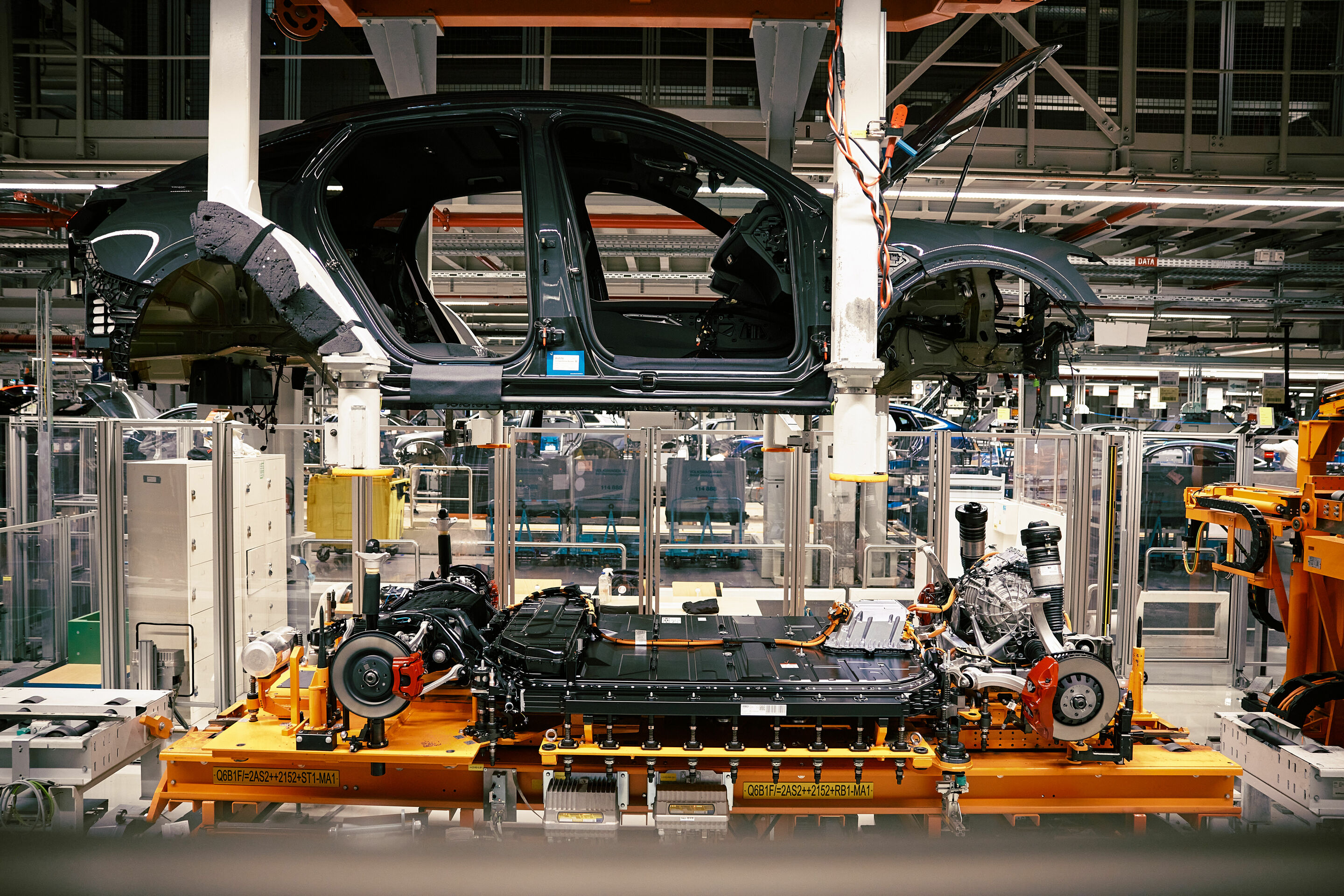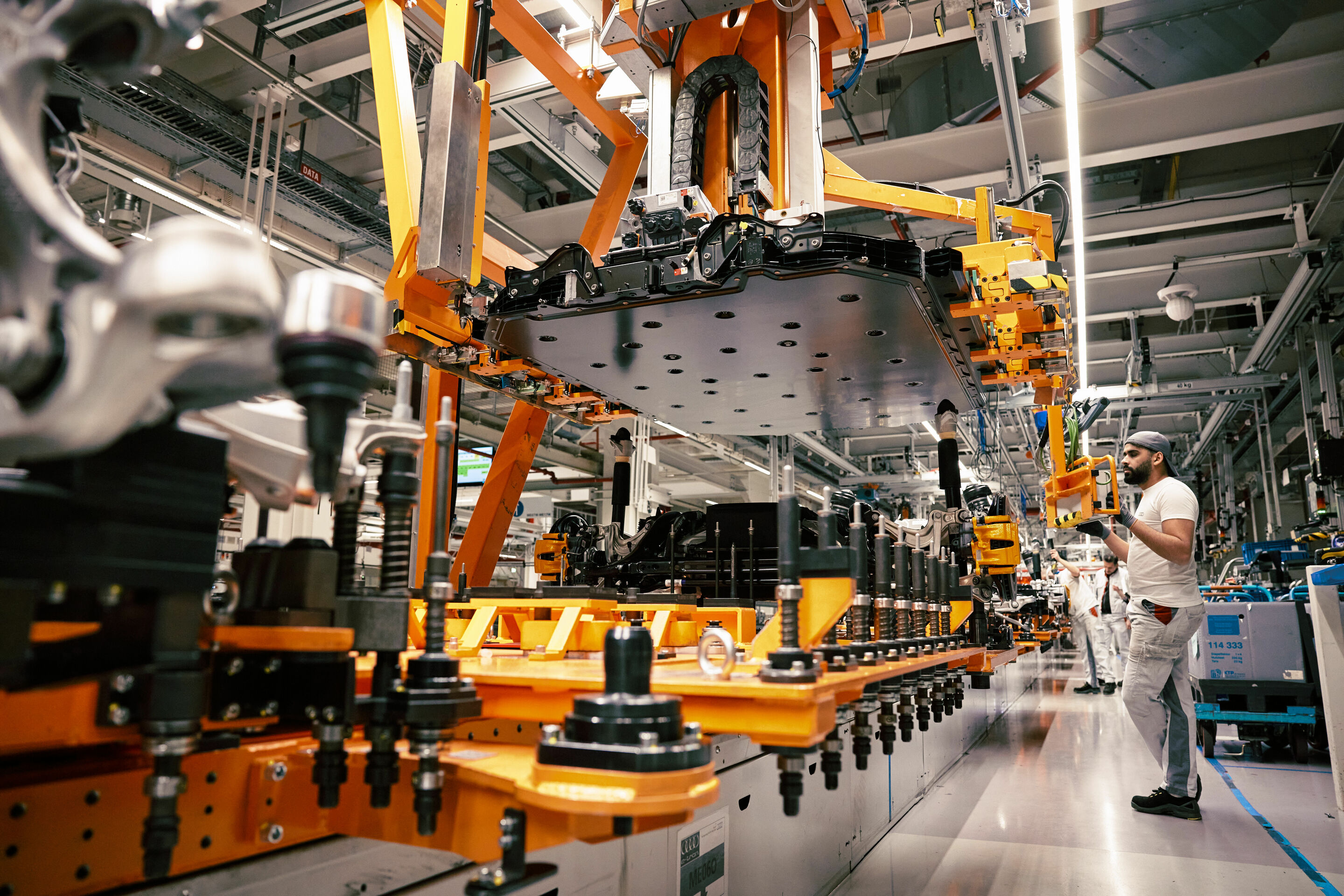Carbon neutral form stage one: Sustainable Production
Back to overviewWhen the new Audi Q8 e-tron leaves production at the Brussels plant in Belgium, it will reach customers in Europe and the United States as a net carbon-neutral1 car. A TÜV certification on its status as a “climate-neutral product” confirms this officially: “Audi ensures that carbon emissions along the supply chain, throughout the production process, and in logistics, among other areas, have been proportionately avoided or reduced through the use of electricity from renewable sources. This explicitly includes the production of the vehicles’ high-voltage battery. In addition, Audi goes further by offsetting unavoidable CO2-equivalent emissions through its support for internationally recognized carbon offsetting projects,” TÜV NORD confirms in its certification.
First carbon-neutral high-volume production plant in premium segment
Since production of the Audi e-tron began in 2018, the plant in Brussels has been recognized as the world’s first certified CO2-neutral high-volume production plant in the premium segment. The site switched to green power back in 2012. Among other things, Audi Brussels installed one of the largest photovoltaic systems in the region on the plant premises, covering 107,000 square meters. It generates around 9,000 megawatt hours of power from sustainable energy per year (enough to charge some 90,000 Audi Q8 e-tron units). The companies that supply the battery cells are also obliged to only use electricity from renewable sources for production.
The second sphere of action involves heating the location with renewable energy. At the Audi plant in Brussels, this coverage comes through biogas certificates. Both of these spheres together cover around 95 percent of the plant’s energy needs. Emissions in production and the supply chain that cannot yet be avoided by means of renewable energy sources are offset using carbon credit projects which are certified by non-profit organizations The Gold Standard or Verified Carbon Standard.
Rail instead of road
As an additional measure, components for battery production no longer reach the Audi plant in Brussels by truck, but instead by DB Cargo freight trains from Hungary. This enables Audi to reduce harmful CO2 emissions. Rail transport over an approximate 1,300-kilometer route, reduces emissions by around 2,600 tons of CO2 per year. The switch to rail transport between Hungary and Brussels began in May 2022 and is scheduled for completion in early 2023.
Wherever possible, Audi uses DB Cargo’s DBeco plus service – for example, for the parts of the route in Austria and Germany. The service sources power exclusively from renewable sources such as wind, water, or solar energy, making transport net carbon neutral.
In Hungary and Belgium, Audi uses DBeco neutral. With this product, the power used for transportation is offset by means of climate certificates, reducing carbon emissions elsewhere.
S rating in the supply chain
To ensure sustainability in the supply chain, Audi uses various tools, including the Sustainability Rating or S rating. This tool helps evaluate suppliers with respect to sustainability, environment, and social wellbeing, regardless of their location and size. The rating is based on a self-assessment questionnaire (SAQ) that suppliers answer, but it also takes into consideration the documents and certificates provided. Whenever it appears necessary, Audi verifies the information on site. Audi only works with companies that pass this audit. In short, Audi uses this procedure to ensure contractual partners comply with the contents of the Code of Conduct for Business Partners. It also lets the company determine the sustainability performance of its suppliers with the S rating being mandatory for all companies that wish to cooperate with Audi and employ more than ten people at their site.
Recyclates and resource-efficient materials
To further help conserve resources, Audi uses a novel plastic construction design for the underride guard in the Audi Q8 e-tron for the first time. Instead of aluminum, the use of high-strength and highly stiff fiber composite materials made from single-variety plastic now significantly reduces the weight of the component by around seven kilograms. This also reduces the CO2 footprint of the underride guard and for the Q8 e-tron overall. The underride guard features a demountable seal that is quick and easy to take off in the event of an inspection.
For subsequent vehicle generations, there are already plans to manufacture the underride guard from recyclates, which would further improve the carbon balance and contribute to the sustainability targets of the brand with the four rings. As the component is made of pure plastic reinforced with glass, it can itself be easily recycled and returned to the material cycle. Recyclates – processed materials derived from a recycling process – are already used in some components of the Audi Q8 e-tron. In addition to reducing carbon emissions, the goal is to establish a closed and thus efficient and sustainable material cycle.
In the interior of the Audi Q8 e-tron, Audi uses recyclates for carpets as well as in insulation and damping materials. The decorative inlay (the tech layer above the display) is available with a novel, anthracite tech fabric made partly from recyclates. In the S line equipment package, the sports seats are upholstered with Dinamica microfiber material and artificial leather. Polyester fibers make up 45 percent of the Dinamica material, which still looks and feels like suede.
The fibers used are obtained from recycled PET bottles, old textiles, or residual fibers. In contrast to the previous microfiber quality, the production of Dinamica is also solvent-free – a further contribution to environmental protection.
Green power in the utilization phase as well
Green power is considered the most effective lever for CO2 reduction in the utilization phase. This phase covers the entire period during which the car is driven by customers, making the provision of fuel or charging power a key factor throughout. It is also during this phase that about half of the carbon emissions a car produces over the course of its life cycle are generated.
For example, Audi customers can already use the green power solutions offered by Volkswagen subsidiary Elli (Electric Life) to charge their cars at home today. For charging on the road, the charging network from IONITY, Europe’s largest open HPC network, also uses green power. Audi’s involvement in this joint venture is the provision of more than 5,000 additional quick-charging points with up to 320 kW of charging power at over 1,000 locations in Europe by 2025.
New wind and solar parks
Audi wants to do its part to uphold the Paris Climate Accords by making the entire company net carbon neutral1 by no later than 2050. To achieve this together with its customers, the brand with the four rings is relying on, among other things, green electricity to power Audi’s electric fleet in Europe. The aim is to increase the amount of green power in the European power grids and thus enable customers to charge with net green electricity. With this initiative, Audi is making a measurable contribution toward offsetting the amount of energy its electric fleet with new additional consumers uses, with power from renewable energy sources. In the process, the company is committed to expanding new sources of renewable power. Together with its cooperation partners, Audi aims to increase the share of electricity generated from renewable sources as well as that of electric cars on the market. By 2025, Audi plans to build new wind and solar parks in various European countries together with several partners, which will generate around five terawatt hours of additional green power. This corresponds to an installed capacity of about 250 new wind turbines.
As the first project to expand the supply of green power in Germany, a solar park in the German state of Mecklenburg-Vorpommern went live in 2022.
1 Audi understands net-zero carbon emissions to mean a situation in which, after other possible reduction measures have been exhausted, the company offsets the carbon emitted by Audi’s products or activities and/or the carbon emissions that currently cannot be avoided in the supply chain, manufacturing, and recycling of Audi vehicles through voluntary offsetting projects carried out worldwide. In this context, carbon emissions generated during a vehicle’s utilization stage, i.e., from the time it is delivered to the customer, are not considered.
2 At least 70 percent of the plastic granulate for the seatbelt buckle covers (including fillers and additives) consists of the pyrolysis oil produced through the project. This pyrolysis oil was secured through the plastic granulate manufacturing process. The assignment of the waste-based pyrolysis oil is carried out within the framework of a mass-balance approach with a qualified credit transfer. This means that ecocycle, an independent external certification agency, confirms that the project members have replaced the amounts of fossil resources required for the seatbelt buckle covers with pyrolysis oil produced from mixed automotive plastic materials. It is intended to provide sufficient pyrolysis oil in the aforementioned volume for the entire production run of the Q8 e-tron on the basis of the currently planned production figures.
All terms marked in the text are explained in detail in the technology lexicon at www.audi-mediacenter.com/en/technology-lexicon. The equipment, data and prices specified in this document refer to the model range offered in Germany. Subject to change without notice; errors and omissions excepted.

